CVI Awareness Month

Image description: The words Cortical Visual Impairment outlined in red using the Roman Word Bubbling App.
Raising Awareness…
Author: Debbie Moody
9-26-2019
The month of September is dedicated to raising awareness about cortical visual impairment (CVI).
Cortical visual impairment (CVI) is an impairment to vision due to injury, damage, or structural abnormalities of the visual centers of the brain. It can be present from birth (congenital) or acquired.
The diagnosis of CVI is increasing due to improved medical care which has increased the survival rate of at-risk babies. CVI is the leading cause of visual impairment in children in all of the developed countries.
CVI is diagnosed by a medical doctor noting three specific criteria:
- A medical eye exam that does not explain the visual function of the individual.
- A history of a medical condition, syndrome, damage, or trauma to the brain is noted.
- The presence of the ten visual/behavioral characteristics specific to CVI. The characteristics include:
- Color preference
- Need for movement
- Visual field preferences
- Difficulties with complexity
- Atypical visual reflexes
- Difficulties with visual novelty
- Difficulty with distance viewing
- Need for light
- Visual latency
- Absence of visually guided reach
(Roman-Lantzy, 2018)
Since CVI is a brain-based visual impairment, it has the potential to improve when the IEP team implements specific interventions and accommodations throughout the child’s day. For example, a child may have a color preference, meaning he can more readily notice objects of a certain color. This color can be used as a visual target in his classroom as in the example in the photo. Neon green is the preferred color for this student, and he can see his cubby in the classroom when it is marked with this color.
Image description: A wall of metal hooks is filled with coats, backpacks, and teddy bear-shaped name cards. One section has neon green paint on the wall from the coat hook to the baseboard near the floor.

Some students demonstrate the need for light. They can be distracted by light and may light gaze as a way to avoid a sensory-rich environment. Students can also be attracted to light and can be redirected to materials when extra light is added. In the picture, a flashlight is used to draw a student’s attention to a toy zebra on the table:
Image description: A plastic toy zebra on the left with spotlighting from a flashlight. A plastic toy giraffe on the right without the spotlight.

Every child with CVI is unique. The strategies used throughout the day are based on an assessment of each child’s visual function and the presence of the characteristics. The most common CVI assessment used in education is the CVI Range by Christine Roman-Lantzy, a teacher of students with visual impairment (TSVI). This tool provides a score on a 0-10 scale that represents the child’s current level of functional vision. Any characteristic that is impacting visual function is addressed with an accommodation or strategy on the child’s IEP.
To support TSVIs, parents, and IEP teams with students who have CVI, the KSSB Field Services CVI Workgroup has created a CVI LiveBinder, which highlights this assessment tool. This resource includes printable information sheets, forms to use, links to favorite websites, literacy strategies, videos, favorite apps, social media suggestions, informative podcasts, and useful product information. This digital binder will expand and evolve, so check back from time to time for added resources. We hope this information is helpful to you and your team!
Enjoy the KSSB CVI Livebinder.
Comments (121)
Comments are closed.



vegas slots free https://2-free-slots.com/
cleopatra slots free https://freeonlneslotmachine.com/
cleopatra slots https://candylandslotmachine.com/
hit it rich casino slots https://pennyslotmachines.org/
ceaser slots https://slotmachinesworld.com/
free jackpot party slots https://slotmachinesforum.net/
downloads ruby slots https://slot-machine-sale.com/
free vegas penny slots https://beat-slot-machines.com/
omg fortune free slots https://download-slot-machines.com/
real casino gambling slots https://411slotmachine.com/
scorchy slots guide https://www-slotmachines.com/
slots plus bonus codes https://slotmachinegameinfo.com/
dissertation help in dubai https://buydissertationhelp.com/
uf dissertation checklist https://dissertationwriting-service.com/
full dissertation help https://help-with-dissertations.com/
dissertation help statistics https://mydissertationwritinghelp.com/
cultural studies dissertation help https://dissertations-writing.org/
help i can’t write my dissertation https://helpon-doctoral-dissertations.net/
2performing
uk dissertation help https://professionaldissertationwriting.org/
electronic engineering dissertation ideas https://professionaldissertationwriting.com/
writing help https://dissertationwritingcenter.com/
dissertation service https://dissertationhelpexpert.com/
dissertation help service binding https://accountingdissertationhelp.com/
how long is a dissertation paper https://examplesofdissertation.com/
dissertation writing plan https://writing-a-dissertation.net/
proposal and dissertation help 3000 words https://customdissertationwritinghelp.com/
dissertation help leicester https://writingadissertationproposal.com/
proquest dissertation https://dissertationhelpspecialist.com/
dissertation help https://dissertationhelperhub.com/
dissertation write https://customthesiswritingservices.com/
online casino real money no deposit https://download-casino-slots.com/
online casino arizona https://firstonlinecasino.org/
how to beat online casino slot machines https://onlinecasinofortunes.com/
rivers casino sportsbook online https://newlasvegascasinos.com/
online casino paypal https://trust-online-casino.com/
best online casino fast payout https://onlinecasinosdirectory.org/
online casino real money usa https://9lineslotscasino.com/
riversweeps online casino app android https://free-online-casinos.net/
online casino free play https://internet-casinos-online.net/
vegas strip online casino https://cybertimeonlinecasino.com/
atlantic online casino https://1freeslotscasino.com/
online casino index https://vrgamescasino.com/
what is the best online casino https://casino-online-roulette.com/
online pa casino https://casino-online-jackpot.com/
online casino free spins https://onlineplayerscasino.com/
real money online casino florida https://all-online-casino-games.com/
rivers casino sportsbook online https://casino8online.com/
best vpn for business https://freevpnconnection.com/
best vpn browser https://shiva-vpn.com/
free p2p vpn https://freehostingvpn.com/
betternet vpn https://ippowervpn.net/
best vpn for apple tv https://imfreevpn.net/
cnet vpn https://superfreevpn.net/
free vpn for laptop https://free-vpn-proxy.com/
free vpn for router https://rsvpnorthvalley.com/
gay mature men dating site in california https://gay-singles-dating.com/
palm springs ca mature gay bisexual dating https://datinggayservices.com/
asien dating online https://freephotodating.com/
christian dating for free https://onlinedatingbabes.com/
single free dating sites for sex https://adult-singles-online-dating.com/
dating sites that are totally free https://adult-classifieds-online-dating.com/
single women local https://online-internet-dating.net/
ourtime login uk https://speedatingwebsites.com/
hinge dating site https://datingpersonalsonline.com/
dating sifes https://wowdatingsites.com/
our time dating website login https://lavaonlinedating.com/
plenty of fish login page https://freeadultdatingpasses.com/
free daing https://virtual-online-dating-service.com/
fdating login https://zonlinedating.com/
top dating websites https://onlinedatingservicesecrets.com/
mgm online casino https://onlinecasinos4me.com/
online casino video poker https://online2casino.com/
wind creek online casino real money https://casinosonlinex.com/
mens gay chat https://newgaychat.com/
gay chat room facebook https://gaychatcams.net/
western pa gay chat https://gaychatspots.com/
gay bisexual chat rooms https://gay-live-chat.net/
gay universe chat https://chatcongays.com/
denver gay chat https://gayphillychat.com/
gay chat cahurbate https://gaychatnorules.com/
gay mature chat https://gaymusclechatrooms.com/
free gay chat lines in fitchburg,ma https://free-gay-sex-chat.com/
zoom cams gay sex chat https://gayinteracialchat.com/
gay dot com chat room https://gaymanchatrooms.com/
where to buy papers https://term-paper-help.org/
website that will write a paper for you https://sociologypapershelp.com/
where can you buy resume paper https://uktermpaperwriters.com/
write my paper please https://paperwritinghq.com/
scientific paper writing services https://writepapersformoney.com/
write my paper fast https://write-my-paper-for-me.org/
pay people to write papers https://doyourpapersonline.com/
custom paper service https://top100custompapernapkins.com/
help with writing papers https://researchpaperswriting.org/
write my college paper https://cheapcustompaper.org/
websites to type papers https://writingpaperservice.net/
buy thesis paper https://buyessaypaperz.com/
help writing a paper https://mypaperwritinghelp.com/
order paper online https://writemypaperquick.com/
help writing my paper https://essaybuypaper.com/
instant paper writer https://papercranewritingservices.com/
custom writing papers https://premiumpapershelp.com/
custom note paper https://ypaywallpapers.com/
buy resume paper https://studentpaperhelp.com/
3abbreviated
coursework help university https://brainycoursework.com/
coursework online https://courseworkninja.com/
coursework masters https://courseworkdownloads.com/
coursework in english https://courseworkinfotest.com/
coursework paper https://coursework-expert.com/
coursework psychology https://buycoursework.org/
coursework history https://courseworkdomau.com/
best free online dating https://freewebdating.net/
best dating online sites https://jewish-dating-online.net/
local dating sites free https://jewish-dating-online.net/
free sites of dating https://free-dating-sites-free-personals.com/
free online dating sites with no fees https://onlinedatingsurvey.com/
date women free https://onlinedatingsuccessguide.com/
dating sites for seniors https://datingwebsiteshopper.com/
dating games https://freedatinglive.com/
best dating online sites https://freewebdating.net/